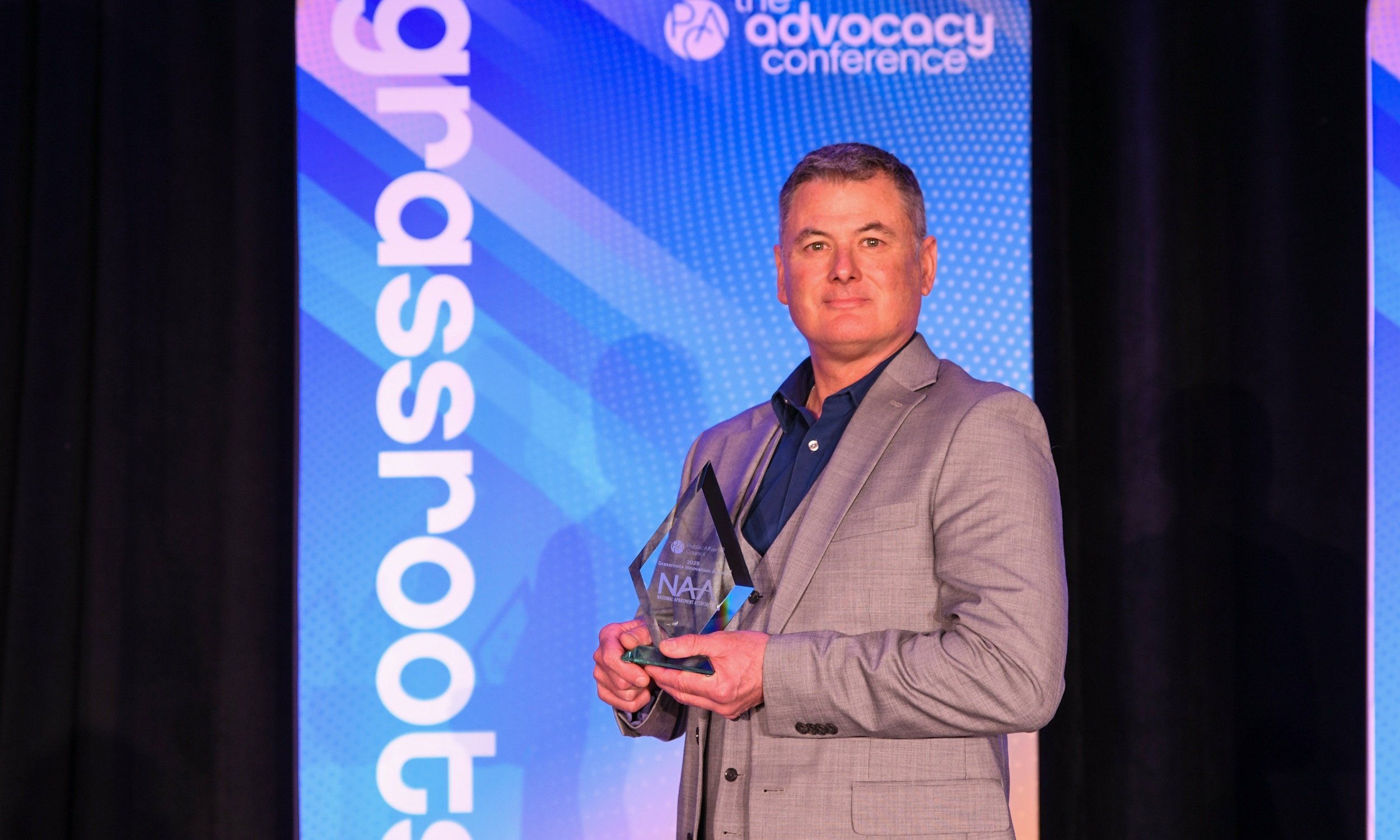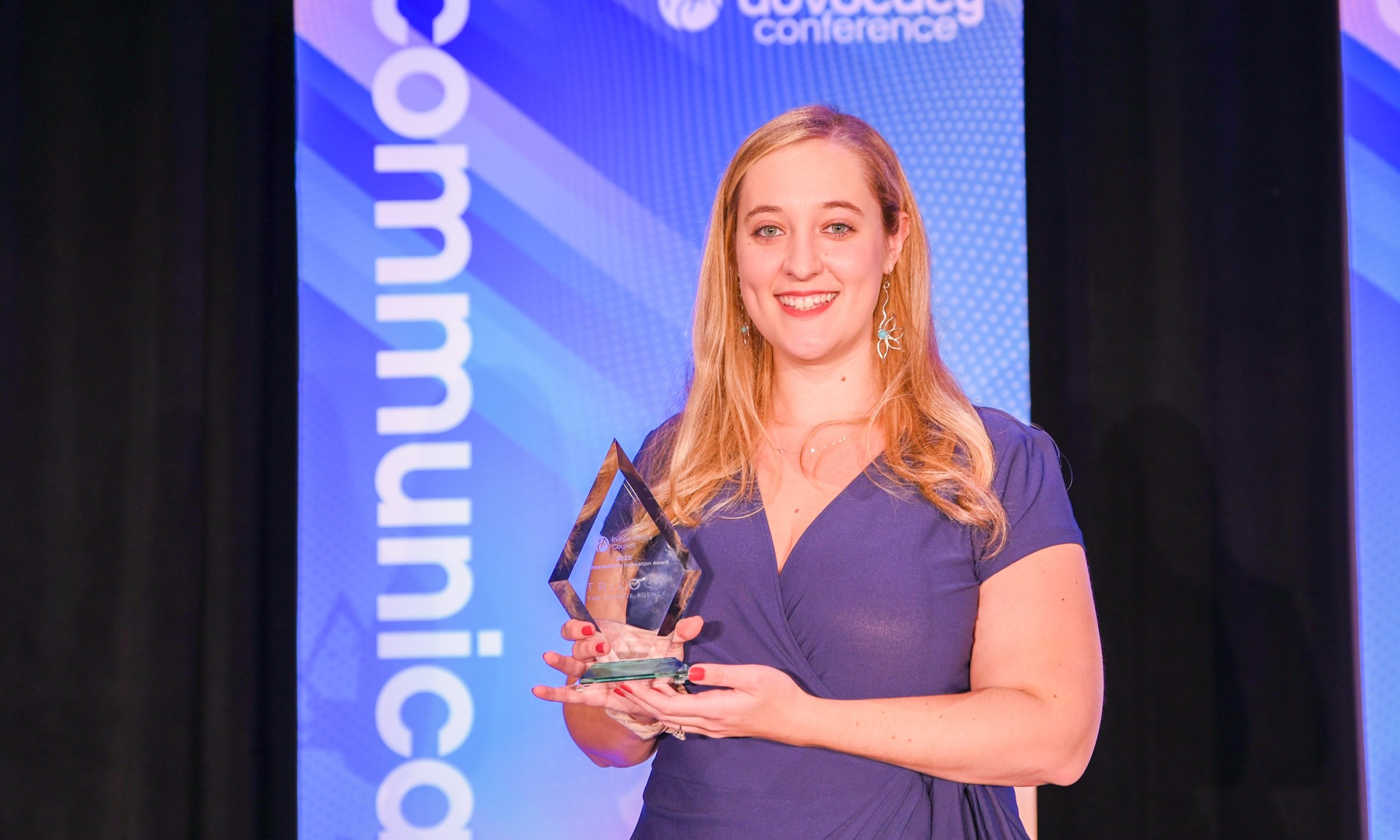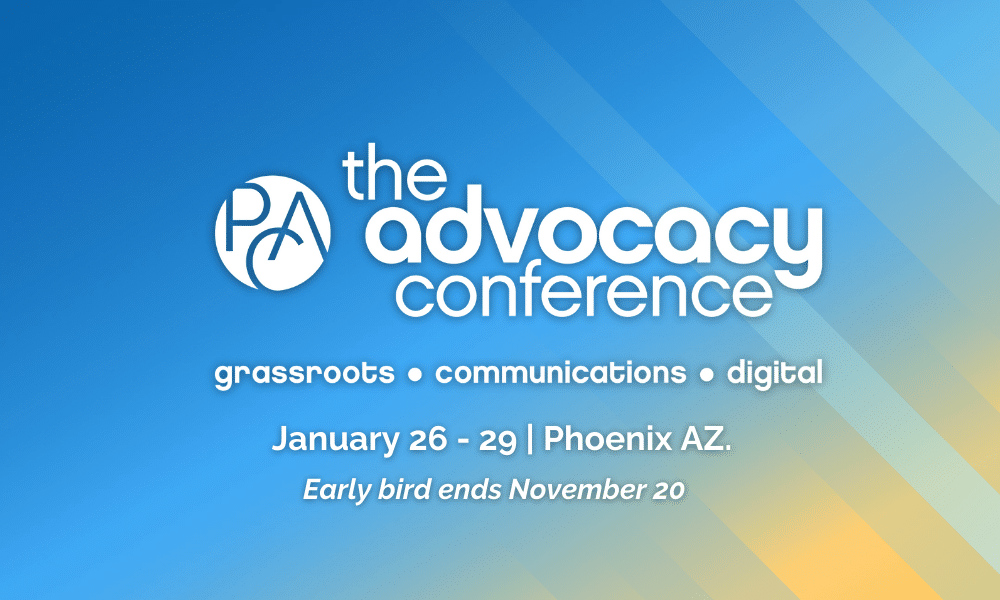Innovation Award Winners Find New Ways to Form and Strengthen Relationships
Even in an increasingly digital world, public affairs still relies on the power of relationships. Whether it’s the relationship between a constituent and their elected official, a business leader and a regulatory agent, or a voter and a trusted messenger, relationships remain at the heart of advocacy campaigns.
As we all consider how to best nurture these relationships, the Public Affairs Council’s 2025 Innovation Award winners demonstrate unique approaches. From using data to uncover and nurture overlooked relationships to painstakingly building trust and understanding among businesses, governments and communities over the course of years to reaching audiences through unconventional but trusted messengers — these creative and thought-provoking campaigns offer all of us lessons in relationship building.

Council President Nneka Chiazor (left) with the 2025 Innovation Award Winners
Grassroots Innovation Award Winner: National Apartment Association
Soon after Seth Turner started his role managing the National Apartment Association’s (NAA) grassroots advocacy and engagement programs, he turned his focus to NAA’s vision for its key contacts network with the goal that NAA would have 535 key contacts, one for each Member of Congress. But when he asked his colleagues to identify key contacts, they could name 5-10 individuals at the most. Those were the “rock star advocates,” the ones that everyone turned to when they needed someone to secure a meeting or testify at a hearing.
But Turner, who has worked in grassroots organizations before, knew from experience that NAA over-relied on those 10 people, risking burnout and missing opportunities to influence key legislators because NAA lacked key contacts who lived in or operated rental housing facilities in those key districts. NAA needed a deliberate strategy to identify advocates hiding beneath the surface, those with potential to become highly influential advocates for NAA. Turner decided to leverage the untapped power of NAA’s Association Management System, powered by Salesforce.
He began by pulling all the disparate data into Salesforce to create advocate profiles, finding hundreds of data files, lists in Excel files, Word docs, emails and NAA’s grassroots advocacy platform. “These lists documented all sorts of advocacy activities, things like webinar and fly in attendance, social media ambassadors, and Advocate of the Year nominees,” explains Turner. “This important information was everywhere, and after we centralized all the information in Salesforce, we discovered so many more involved yet overlooked advocates that NAA needed to engage to transform them into super advocates.”
From Influence to Recruitment
Next, Turner analyzed his digital advocates – the ones who sent letters to elected officials when asked through NAA’s mass email campaigns. What he discovered was concerning: Only 20% of NAA’s grassroots advocates ever went on to participate in a second advocacy campaign.
That told him that NAA’s grassroots advocates become cynical quickly and that sending those emails doesn’t make much of a difference. “It confirmed what I learned from my work at the Congressional Management Foundation, which finds that sending form emails to Members of Congress is one of the least effective advocacy tactics,” says Turner.
But it also told him that NAA needed to do more outreach to advocates who are optimistic enough to participate in form email campaigns more than once. “We stopped viewing mass email campaigns as an influencing tool and started viewing them as a recruitment tool,” Turner notes. “This perception shift caused NAA to treat campaign participants differently.”
Now, when someone takes a second or third digital action, Turner does more personal outreach, acknowledging their efforts and offering them opportunities and resources to learn more about tools they could use to be a more effective advocate for NAA.
Surfacing Existing Relationships
The final piece of this data-driven approach was to survey NAA’s members to learn about their relationships with Members of Congress and to determine how influential each relationship was. NAA sent the survey to its membership, and leaders across their network of 141 affiliate partners also circulated the survey.
NAA discovered 61 relationships in less than a month. One respondent shared the following: “I held office as a City Councilwoman in Wilmington, Ohio, for two terms and had relationships with several members of state/federal government due to my work on City Council. I was also president of our party’s women’s group locally, and candidates would visit and attend meetings.”
“The amazing thing about that information is that the person who shared wasn’t even in NAA’s database. Here we had a person who clearly had a strong and extensive network of political contacts, and no one had even heard of her,” says Turner. “I reached out to her immediately.”
As NAA continued to identify and nurture key contacts and grasstops advocates, it rated each advocate’s advocacy sophistication using a scale of 1-5. By tracking and rating in this way, the data showed what needed to be done next to move the advocates up the ladder of engagement. “After several months, the data showed us that we were good at finding key contacts with new potential, but we weren’t converting our mid-level advocates into top-level advocates,” Turner says. “That was the key to convincing NAA’s leadership to make a substantial investment to conduct our first-ever advocacy academy last year. We provided training targeted for 25 mid-level advocates and converted them into top-level advocates. Overnight, the number of top-level advocates increased by 150%.”
The advocacy academy’s success created unexpected benefits with affiliates getting better advocates engaged in local- and state-level efforts and NAA getting more advocates who can engage in national-level issues.

Grassroots Innovation Award Winner Seth Turner with the National Apartment Association
Communications Innovation Award Winner: Trilogy Interactive and Americans for Contraception
Public affairs communications tend to target advocates and activists who are already politically engaged. While that can be an effective approach, the truth is it leaves a lot of people out of the conversation.
Americans for Contraception’s polling showed that while a large majority of people supported birth control, almost none of them believed that access was under any serious threat. Meanwhile, on social media, young people were getting dangerous and misleading messages about birth control. On TikTok, hashtags like #IVFJourney or #PCOSStory funneled people (mostly young women) toward anti-science content urging them to #DitchThePill.
This signaled to the organization that this was bigger than an advocacy problem — this was an information problem. Apolitical millennial and Gen Z audiences were often getting their information from trusted social media creators, so Americans for Contraception teamed up with Trilogy Interactive to deliver those audiences the information they needed from the people they trusted most.
Connecting to New Audiences Through Trusted Creators
Trilogy Interactive recruited 181 content creators on TikTok and Instagram to outcompete misinformation and disinformation about birth control and to advance legislation to protect birth control rights. The content earned more than 24 million views and 2 million engagements in 2024.
Most of the creators who took part in this effort had never used their platforms for issue advocacy before. “A key to our success was inspiring creators to understand the issue’s urgency and then empowering them to talk about the issue in their own unique way,” says Jenn Colton, vice president of strategic services at Trilogy Interactive and a lead strategist for this campaign.
That meant letting reality TV stars, mom bloggers and other content creators talk about birth control in ways that were authentic to them and would ring true to their audiences. The Bachelor and The Bachelorette contestants Katie Thurston and Susie Evans imagined what reality dating shows would look like if the same politicians banning our birth control were in charge. Real Housewives Emily Simpson and Gina Kirschenheiter chatted about “kissing frogs” to find a prince.
“The most powerful part about working with creators is the relationship they have with their audience,” says Colton. “If you’re taking parenting advice from an online creator, that’s someone you trust intrinsically. And that made their content about birth control even more powerful.”
The content racked up more than 24 million views in 2024 and generated a number of attention-grabbing headlines. But perhaps most important, those views translated into real-world impact. In Nevada, where the campaign worked closely with creators, the Right to Contraception Act passed the state legislature with bipartisan support (though it was ultimately vetoed). Meanwhile, in North Carolina, where there wasn’t a similar creator program, the Right to Use Contraception Act failed to advance.
Colton has a word of advice for anyone looking to replicate the success of this campaign: “This isn’t organic content. Think of this approach like any other type of paid media campaign,” she says. “You’re paying for the platform these people have, just like you’d pay to run an ad on a television channel, except content creators are the more relevant form of media for millennial and Gen Z audiences.”

Communications Innovation Award Winner Jenn Colton with Trilogy Interactive
Lobbying Innovation Award Winner: Grupo Estrategia Política
Sometimes you can reach audiences digitally for the highest impact. But other times, it’s necessary to build trust and relationships slowly, face-to-face.
That’s the approach Grupo Estrategia Política (GEP) took for its client, a logistics and courier company in Chiapas in southern Mexico. Back in 2016, the Mexican shipping industry faced major regulatory burdens. Despite transporting local goods throughout the country, the company was not recognized as a player in the transportation union and faced multiple regulatory bills without any meaningful relationships with local or state governments.
GEP understood that while local and state governments might not have a stake in the fortunes of the courier company, they did want to see their local artisans and economy thrive. So GEP put together a series of agreements between the courier company, local governments, and small- and medium-sized enterprises (SMEs) — giving those SMEs access to reduced shipping rates to benefit local economies.
The signing ceremonies were attended by government officials, local artisans and community members, as well as top management of the courier company. The head of the company was always involved and attended each signing ceremony, signaling to everyone that the company cared about growing the local economy. The strategy also allowed leadership to forge critical relationships with business leaders and local governments.
Building Trust Over Time
“Sometimes in public affairs, you’re looking for a quick win, but this is an example of a long-term strategy that gives you a lot over time,” says Gustavo Almaraz, executive president of GEP. “This relationship-intensive approach has been so successful we’ve been asked to replicate it with other companies. They recognize that this approach is now a best practice.”
And while the courier company has been able to build strong government relationships and increase its business, Almaraz points out that the benefits go far beyond that. “At GEP, we’re always looking for our public affairs and advocacy to have a social impact,” he says. In this case, he sees local Mexican artisans and businesses able to afford shipping their goods to other Mexican states and even internationally. SMEs across Mexico have been able to grow and thrive, even through COVID-19.
“Think It All the Way Through to the End”
If GEP sounds familiar, that’s because this is its second Innovation Award — in a row. Last year, it won the Innovation Award for Lobbying for a rapid response campaign to ensure that Mexico’s aviation industry could continue operating internationally.
Whether the campaign is fast or slow, GEP is able to innovate in its field thanks to its unique approach. “No matter the timeline, no matter what the client is challenging us to do, we have a strong methodology for our campaigns,” says Almaraz. “We always put our strategy in writing, and we think it all the way through to the end. Then, even when things change over time, we have a road map. Sticking to that road map is what encourages us to get creative and try new things to reach the outcome.”
“Our judges were very impressed with the creativity that all three of these winners showed in their innovative campaigns,” says Alex Donovan, manager of public affairs and policy communications at the Public Affairs Council. “One of the factors we look at is how replicable these ideas are for other organizations. All three of these approaches can be applied throughout our sector to make our work more innovative and effective.”
About the Innovation Awards
The Innovation Awards were presented at the 2025 Advocacy Conference where winners shared what made their campaigns successful.
Could your organization be a future winner? Learn more.

Lobby Innovation Award Winner Gustavo Almaraz with Grupo Estrategia Política
More News & Resources
Whether you’re building cutting-edge campaigns, engaging communities on social, mobilizing advocates, or exploring the power of new AI tools, THIS is where the future of advocacy comes alive.


